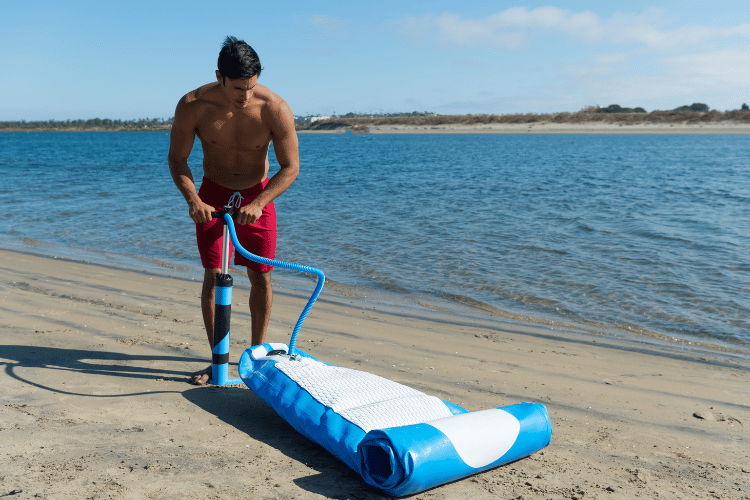Inflatable paddle boards have revolutionized water sports with their portability and convenience. However, a common problem that can spoil the paddling experience is leaks around the valve.
The valve plays a critical role in maintaining the board’s air pressure and overall performance. When leaks occur around the valve, they can lead to a loss of air over time, which affects stability and maneuverability.
The main causes of inflatable paddleboard leaking around the valve are wear and tear, poor initial installation, excessive pressure or overinflation, and environmental factors.
In this post, we dive deep into the causes of this issue, identify the signs of a leaking valve, and go over effective solutions to ensure a safe and enjoyable paddle-boarding adventure.

Understanding Inflatable Paddle Board Valves
Valves in inflatable paddle boards allow for easy inflation and deflation. They control the entry and exit of air, making the boards convenient for storage and transport.
A secure valve seal is essential for several reasons.
Firstly, it keeps the paddle board properly inflated during use, providing stability and buoyancy on the water. A compromised valve seal can result in air leakage, affecting the board’s rigidity and overall performance.
Secondly, a secure seal prevents water from infiltrating the inner chambers of the board, which can impair buoyancy and cause damage or mold growth.
Lastly, maintaining a secure seal helps preserve the valve’s lifespan, as exposure to UV rays and moisture can lead to deterioration and air leaks.
By prioritizing a secure seal around the valve area, inflatable paddle board owners can ensure their boards remain functional, reliable, and enjoyable for years to come.
Causes of Inflatable Paddle Board Valve Leaks
By understanding the main causes of leaks around valves in inflatable paddle boards, you can prolong the lifespan of your board, maintain its overall functionality, and enjoy worry-free water adventures.
Here are the four main causes of inflatable SUP valve leaks:
1. Wear and Tear Over Time
Over time, inflatable paddle boards tend to experience some wear and tear, and the valve area is no exception. This is especially common among cheaper models.
Factors like continuous inflation and deflation, exposure to sunlight, and general usage can cause degradation of the valve and its surrounding material. They can also result in broken seams.
As the inflatable paddle board ages, the seal around the valve may become less secure, which leads to potential air leakage.
2. Poor Initial Installation
Improper valve assembly or installation during the manufacturing process or when replacing a valve can contribute to leaks.

If the valve is not securely attached or aligned correctly with the paddle board’s material, it can create gaps, weak points, or faulty seams where air can escape.
Inadequate adhesion or incomplete sealing during installation can also result in seam issues, a loose valve, and leaks around the valve area.
3. Excessive Pressure (Overinflation)
Overinflating the paddle board can put excessive strain on the valve and its surrounding area, causing leaks.
When the board is inflated beyond the recommended pressure, it creates added stress on the valve’s seal, potentially causing it to fail.
Similarly, subjecting the board to excessive pressure, like sitting or standing on it with excessive force, can contribute to leaks around the valve.
Adhering to the manufacturer’s inflation guidelines and avoiding excessive pressure on the board can help prevent these leaks.
4. Environmental Factors
Environmental factors play a significant role in causing leaks around valves in inflatable paddle boards. Exposure to extreme heat, prolonged sunlight, and UV rays can degrade the materials around the valve, including the sealant or adhesive used to secure the valve.
High temperatures can cause expansion and contraction, creating stress on the valve and potentially compromising the seal.
Sharp objects, such as rocks or debris in the water, can puncture the paddle board, including the area around the valve.
It is important to be mindful of the environment and take precautions to protect the board from these factors, like avoiding rocky areas and using protective covers or bags when not in use.
Detecting Leaks in Inflatable Paddle Boards
Detecting leaks around valves is crucial for prompt repairs and preventing further damage to the inflatable paddle board.
Here are some of the most effective ways to detect leaks in your inflatable paddle board:
Visual Inspection
A visual inspection is the first step in detecting leaks around valves in inflatable paddle boards. Carefully examine the valve area, looking for any signs of damage, like tears, cracks, or gaps in the seal.
Pay close attention to the valve itself, the surrounding material, and the sealant or adhesive used to secure it. If you notice any abnormalities or suspect a leak, proceed with further testing to confirm the issue.
Soapy Water Test
The soapy water test is a popular method for detecting leaks in inflatable paddle boards.
- Mix a solution of mild soap and water and apply it generously around the valve area.
- Gently pressurize the board by inflating it slightly.
- Look out for any bubbles forming in the soapy water.
- If bubbles emerge around the valve, there’s a leak.
- Take note of the exact location of the leak for effective repairs.
Water Submersion
Submerging the board in water is another effective method for detecting leaks.
- Inflate the board partially and immerse it in a pool, lake, or large container of water.
- Slowly move the board around, paying close attention to the valve area.
- Look for air bubbles rising to the water’s surface, which will indicate a leak.
Take caution not to fully submerge the electrical components, if any, of the paddle board during this test.
Leak Detection Tools
Leak detection tools and devices can aid in finding leaks around valves with greater accuracy. Some options include handheld electronic leak detectors, ultrasonic leak detectors, or even fluorescent dyes that reveal leaks under specific lighting conditions.
These tools can provide more precise information about the location and severity of the leak, enabling targeted repairs and minimizing the potential for further damage.
Repairing Leaks Around Paddle Board Valves
Now that you know the causes of valve leaks in an inflatable paddle board and how to detect them, let’s discuss how you can go about fixing these leaks.
1. Gathering the Necessary Tools
Before beginning the repair process, you need to gather the necessary tools and materials.
You will typically need a repair kit specifically designed for inflatable boards, which includes patches, adhesives, applicators, and sometimes even a valve wrench.
All-inclusive kit
Eco-friendly and UV resistant
For all types of surf crafts
Additionally, have a clean cloth, isopropyl alcohol or a suitable cleaner, and scissors or a utility knife on hand.
Ensure that you have a well-ventilated workspace and follow safety precautions while handling any adhesives or solvents.
2. Finding the Location of the Leak
Using visual cues from previous inspections or conducting additional leak detection tests such as the ones mentioned above, you need to pinpoint the precise spot where the air is escaping.

Mark the area with a pencil or tape to guide you during the repair process.
3. Applying a Suitable Sealant
Clean the area around the leak using isopropyl alcohol or a suitable cleaner to remove any dirt, debris, or residue that could interfere with adhesion. Ensure that the surface is completely dry before proceeding.
Depending on the size and severity of the leak, apply a suitable patch from your patch kit or a compatible repair sealant over the identified area.
Follow the manufacturer’s instructions for applying the patch or sealant correctly.
Protects against leaks and air loss
Works for all marine inflatables
Made of natural latex
4. Ensuring a Tight and Secure Seal
Carefully press the patch or apply pressure to the sealant to create a secure bond between the patch and the paddle board’s material.
Then, smooth out any wrinkles or air bubbles to ensure a tight seal.
5. Allowing Enough Drying Time
Allow sufficient drying time as specified by the patch or sealant manufacturer before reinflating the paddle board. This will ensure that the repair sets properly and effectively stops the leak.
It’s essential to closely follow the instructions provided with your patch kit or repair sealant, as different products may have specific guidelines and drying times.
Also, pay attention to any additional recommendations for reinforcing the repair or performing a secondary application for added durability.
Preventing Inflatable Paddle Board Valve Leaks
Here are a few preventative tips to help you avoid valve leaks in your inflatable paddle board in the future:
- Follow the manufacturer’s guidelines for proper inflation and deflation of the board.
- Avoid overinflating the board or subjecting it to excessive pressure.
- Inspect the valve from time to time for signs of wear and tear, like cracks or gaps.
- Ensure a secure installation of the valve based on the manufacturer’s instructions.
- Protect the paddle board from extreme heat, prolonged direct sunlight, and UV rays.
- Avoid exposing the board to sharp objects or debris in the water to avoid punctures.
- Remove any dirt, debris, or residue that may compromise the seal.
- Store the paddle board properly when not in use, in a cool and dry place.
- Consider using protective covers or bags for storage.
Wrapping Up
In conclusion, addressing and preventing leaks around valves in inflatable paddle boards is crucial for maintaining their performance, durability, and safety.
By understanding the common causes of leaks and implementing preventive measures such as proper installation, regular inspections, and careful maintenance, you can easily minimize the risk of iSUP valve leaks.
Promptly detecting and repairing leaks using appropriate techniques and materials ensures the integrity of the inflation valve area and extends the lifespan of the board.
In cases where the leak is extensive, the valve itself is so damaged that you need a replacement valve. If the repair is beyond your skill level, it’s recommended to seek professional assistance or consult the manufacturer.
They can provide guidance or recommend specialized repair services to ensure the board’s safety and optimal performance.




